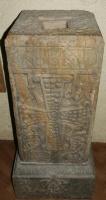
It is said that inside a hollow space in the engraved pillar, Saunière found four parchments. The first containing Latin text fragments of Luke VI, 1-5 and Matthew XII, 1-8, Mark II, 23-28, the second containing the story in which Jesus visits Lazarus in Bethania from the Gospel of John and two genealogies of Dagobert II, dating from resp. 1244 and 1644. It is sometimes claimed there was a fifth document: the will of Henri d’Hautpoul dated 1695. In actual facts the cavity at the top of the pillar is the size of a big matchbox and couldn’t have contained 4 parchments. If Saunière discovered papers it is more likely he found them in the wooden baluster as witnessed by his bellringer Antoine Captier.
On the 21st of June 1891, 24 children of the village received first communion. Since this was a major event for the small village a ‘Mission’ was organized. A statue of Notre Dame de Lourdes was carried around the whole village by four men in a procession that included most of the villagers and their children. At the end of the procession, the statue was placed on a piedestal, consisting of the decorated pillar that once supported the original altar of the Eglise Madeleine. Oddly enough he placed the pillar upside-down and had it engraved ‘Pénitence, pénitense, Mission 1891’.
The placement of the pillar has led to a much speculation. It was a Visigoth custom to bury their kings below an upside-down cross. It is today believed by some researchers that the pillar marks the, outer wall, of the, crypt of the Eglise Madeleine.

The original altar pillar when it was replaced for a reproduction on May 29, 1993
The pillar is more likely to be of Carolingian than of Visigoth origin judging by it’s Christian depiction of a cross with jewels and branches. The pillar has matching engravings with those found at the abbey of St. Guilhem-le-Désert. Archaeologist Brigitte Gibrac-Lescure has suggested they might have been carried out by the same artist.
Abbé Saunière used a number of inversions while decorating his domain and church of which this pillar is a nice example.
The pillar currently on display outside supporting Notre Dame de Lourdes is a reproduction. The oridinal was replaced on May 29, 1993. The original is now in the museum.


Could you confirm all the markings visible on this stone pillar please. What are the designs?
Thank you, Sheila